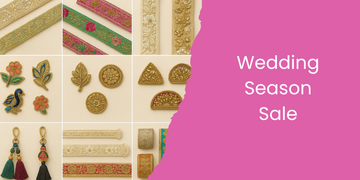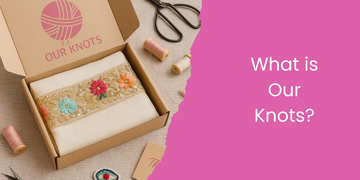Lace has been a timeless fabric, cherished for its delicate beauty and intricate patterns. It has a long history of use in fashion, home decor, and even wedding attire. Among the many types of lace, embroidered lace and guipure lace are two of the most popular options, often confused for one another. While both types feature stunning detailing, they differ significantly in their design, texture, and application. This blog will explore the differences between embroidered lace and guipure lace, helping you decide which one is best for your needs.
Here is a comparison of Embroidered Lace and Guipure Lace in tabular form:
|
Feature |
Embroidered Lace |
Guipure Lace |
|
Composition |
Lace with embroidery stitched on a sheer base |
Lace with intricate woven designs, no sheer base |
|
Transparency |
Semi-transparent, lightweight |
Opaque, non-transparent |
|
Design |
Delicate, floral or geometric patterns with added embroidery |
Intricate, self-contained woven designs like floral or geometric |
|
Texture |
Soft, airy, and delicate |
Heavier, more structured and durable |
|
Weight |
Lightweight |
Heavier and sturdier |
|
Common Uses |
Wedding gowns, blouses, veils, delicate garments |
Statement pieces, evening wear, outer garments, accessories |
|
Durability |
Less durable, more delicate |
More durable, maintains shape and detail |
|
Application |
Perfect for layering or accentuating fabrics |
Ideal for stand-alone pieces, requiring no underlayer |
This table summarizes the key differences, helping you choose the right lace type for your project!
What is Embroidered Lace?
Embroidered lace is a fabric that combines lacework with embroidered elements. In this type of lace, embroidery stitches are added to a sheer lace base, enhancing the design with intricate patterns, textures, and embellishments. The embroidery can be done with a variety of threads, including cotton, silk, or metallic threads, depending on the desired effect. This lace is often used for making delicate garments like dresses, blouses, or veils, adding a luxurious and ornate touch to any outfit.
The most notable feature of embroidered lace is its versatility. The embroidery can be done in a range of styles and designs, from floral to geometric patterns. The lace itself is usually lightweight and semi-transparent, making it ideal for layering over fabrics to add depth and texture without overwhelming the outfit.
What is Guipure Lace?
On the other hand, guipure lace (also known simply as guipure) is a heavier, more structured lace that is distinct from embroidered lace. Guipure lace is made by weaving intricate designs directly into the fabric, without the use of a sheer base. This results in a fabric that is more solid and often used to create statement pieces in both fashion and interior design. Unlike embroidered lace, where the embroidery is stitched onto a base fabric, guipure lace is self-contained, meaning that the designs are created by the threads themselves, forming a non-transparent, sturdy fabric.
Guipure lace is often favored for its durability and elegance. It can come in various patterns, including floral, geometric, and abstract designs, which are woven into the fabric using delicate threads. Guipure lace for sale is often found in both traditional and modern collections, offering a luxurious alternative to other types of lace, thanks to its ability to hold its shape while maintaining intricate detail.
Key Differences Between Embroidered Lace and Guipure Lace
- Composition and Construction:
- Embroidered lace has a sheer lace base with embroidery applied on top, which gives it a lighter, more delicate feel.
- Guipure lace is a non-transparent fabric with intricate designs woven into the lace itself, creating a denser, sturdier texture.
- Transparency:
- Embroidered lace is often semi-transparent, making it ideal for layering or accentuating the fabric beneath.
- Guipure lace is typically more opaque and does not require an underlayer for coverage, making it a great choice for more structured designs.
- Use in Fashion:
- Embroidered lace is commonly used in delicate garments such as wedding dresses, blouses, and lingerie, where its light, airy quality enhances the overall appearance.
- Guipure lace, with its heavier, more intricate texture, is often used in statement pieces like evening wear, outer garments, or accessories like shawls and collars.
- Weight and Durability:
- Embroidered lace is lighter and more delicate, making it less durable but perfect for elegant, soft draping.
- Guipure lace is heavier and more durable, making it suitable for garments or accessories that need to withstand wear and tear.
Where to Buy Guipure Lace for Sale?
If you're in the market for guipure lace for sale, there are many online stores and fabric shops that offer high-quality options. Look for reputable suppliers that specialize in lace fabrics, ensuring that you get the best quality for your needs. Whether you are creating a wedding gown or looking to add a luxurious touch to your wardrobe, guipure lace provides a timeless appeal with its beautiful textures and designs.
Conclusion
While embroidered lace and guipure lace may seem similar at first glance, they have key differences that make them suitable for various applications. Embroidered lace is delicate, airy, and ideal for soft, elegant garments, while guipure lace is a sturdy, intricate fabric perfect for more structured designs. Understanding these differences will help you choose the right lace for your next fashion or home decor project. Whether you're in search of guipure lace for sale or considering embroidered lace for your next creation, both types offer unique beauty that can elevate any design.






